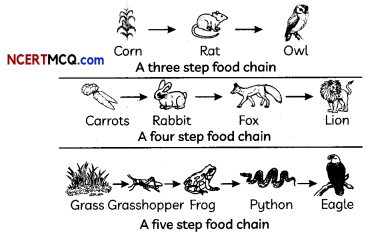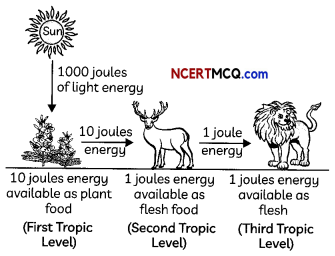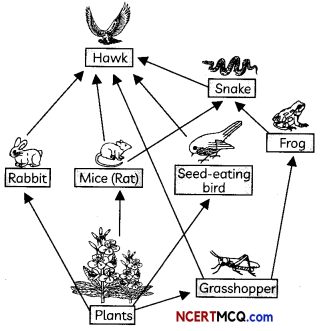Food Chains and Food Webs
Food or energy can be transferred from one organism to the other by means of food chains. All the food chains begin with the autotrophs as they are the producers of food. Food chain is therefore the sequence of living organisms in a community in which one organism consumes another organism to transfer energy.
Examples of Food Chain
Following are a few examples of food chains:
- Grass → Deer → Lion
- Grass → Insects Frog → Birds
- Plants → Worms → Birds → Cat
- Algae → Protozoa Small Fish → Big Fish

Example 1.
Which of the following constitute a food-chain?
(a) Grass, wheat and mango
(b) Grass, goat and human
(c) Goat, cow and elephant
(d) Grass, fish and goat
Answer:
(b) Grass, goat and human
Explanation: In a food chain, organism at the higher trophic level feeds on the organism at the Lower trophic level. As goat feeds on grass and humans feed on goats, this is the correct option.
Trophic Levels
The various steps in a food chain at which the transfer of food or energy takes place are called trophic levels. In a food chain, each step forms a trophic level.
- The autotrophs or the producers are at the first trophic level. They fix up the solar energy and make it available for heterotrophs or consumers.
- The herbivores or the primary consumers come at the second trophic level.
- Small carnivores or secondary consumers are at the third trophic level.
- Larger carnivores or tertiary consumers form the fourth trophic level.
An example of trophic level: Consider the food chain in a grassland:
Grass → Insects → Frog → Birds
In this food chain, grass represents the 1st trophic Level, insects represent the 2nd trophic level, frog represents the 3rd trophic level and birds are at the 4th trophic level.
The flow of Energy in a Food Chain
- The green plants in a terrestrial ecosystem capture about 1% of the energy of sunlight that falls on their leaves and convert it into food energy.
- When green plants are eaten by primary consumers, a great deal of energy is lost as heat to the environment, some amount goes into digestion and in doing work and the rest goes towards growth and reproduction.
- Ten percent law: An average of 10% of the food eaten is turned into its own body and made available for the next level of consumers. There¬fore, 10% can be taken as the average value for the amount of organic matter that is present at each step and reaches the next level of con¬sumers.
- A number of trophic levels are limited: Since so little energy is available for the next level of consumers, food chains generally consist of only three or four steps. The loss of energy at each step is so great that very little usable energy remains after four trophic levels. There are generally, a greater number of individuals at the lower trophic levels of an ecosystem, the greatest number is of the producers.
![]()
Example 2.
Will the impact of removing all the organisms in a trophic level be different for different trophic levels? Can the organisms of any trophic level be removed without causing any damage to the ecosystem?
Answer:
Yes, the impact of removing all the organisms in a trophic level be different for different trophic levels. As the largest number of organisms are at the producer level and least number at the highest trophic level in any food chain, removal of organisms at producer level will have an impact on the next higher level as those organ-isms will starve. On the other hand, if organisms belonging to a higher trophic level are removed, the organisms belonging to the lower trophic level will increase greatly in number. This will lead to an ecological imbalance.
No, whenever organisms of any trophic level are removed, it will adversely affect the ecosystem and our environment
Illustration of the 10 percent law: Suppose 1000 joules of light energy emitted by the sun falls on the plants (called producers). We know that the plants convert only one per cent (1%) of the light energy falling on them into chemical energy of food. So, the energy which will be available in plant matter as food will be only 1% of 1000 Joules, which comes to 10 joules. The remaining 1000 – 10 = 990 joules of light energy or solar energy which is not utilized by the plants is reflected back into the environment (see Figure). The ten per cent law will not apply at this stage. It will apply only in the transfer of energy in a food chain.
According to the 10% law, only 10% of 10 jouLes of energy i.e., 1 Joule will be available for transfer to the next trophic level.

![]()
Food Web
The network of a large number of food chains existing in an ecosystem is called a food web. As the length and complexity of food chains vary greatly and each organism is generally eaten by two or more other kinds of organisms which in turn are eaten by several other organisms. So, instead of a straight line food chain, the relationship can be shown as a series of branching lines called a food web

There are six food chains in the above food web, marked as 1, 2, 3, 4, 5 and 6.
1. In the 1st food chain, plants are eaten by rabbit and then rabbit is eaten by hawk:
Plants → Rabbit → Hawk
2. In the 2nd food chain, plants are eaten by mice and the mice are eaten by hawks:
Plants → Mice → Hawk
3. In the 3rd food chain, plants are eaten by mice; mice are eaten by snakes and then snakes are consumed by hawks:
Plants → Mice → Snake → Hawk
4. In the 4th food chain, plants are eaten by seed-eat¬ing birds and the seed-eating birds are consumed by hawks:
Plants → Seed-eating Bird → Hawk
5. In the 5th food chain, plants are eaten up by grasshopper and the grasshopper is consumed by hawks:
Plants → Grasshopper → Hawk
6. In the 6th food chain, plants are eaten by grasshopper, grasshopper is eaten by frog; frog is eaten by snake and then the snake is consumed by hawk:
Plants → Grasshopper →Frog → Snake → Hawk
Energy Flow Diagram
If we study the energy flow diagram in a food chain, we find that the flow of energy is unidirectional. The energy that is captured by the autotrophs does not revert back to the solar input and the energy which passes to the herbivores does not come back to the autotrophs.
Biological Magnification
The increase in concentration of harmful chemical substances like pesticides in the body of living organisms at- each trophic level of a food chain is called biological magnification. These chemicals are absorbed from the soil by the plants and from the water bodies by the aquatic plants and animals. As these are non-biodegradable, they get accumulated progressively at each trophic level. This is also the reason why our food grains such as wheat and rice, vegetables and fruits contain varying amounts of pesticide residue.